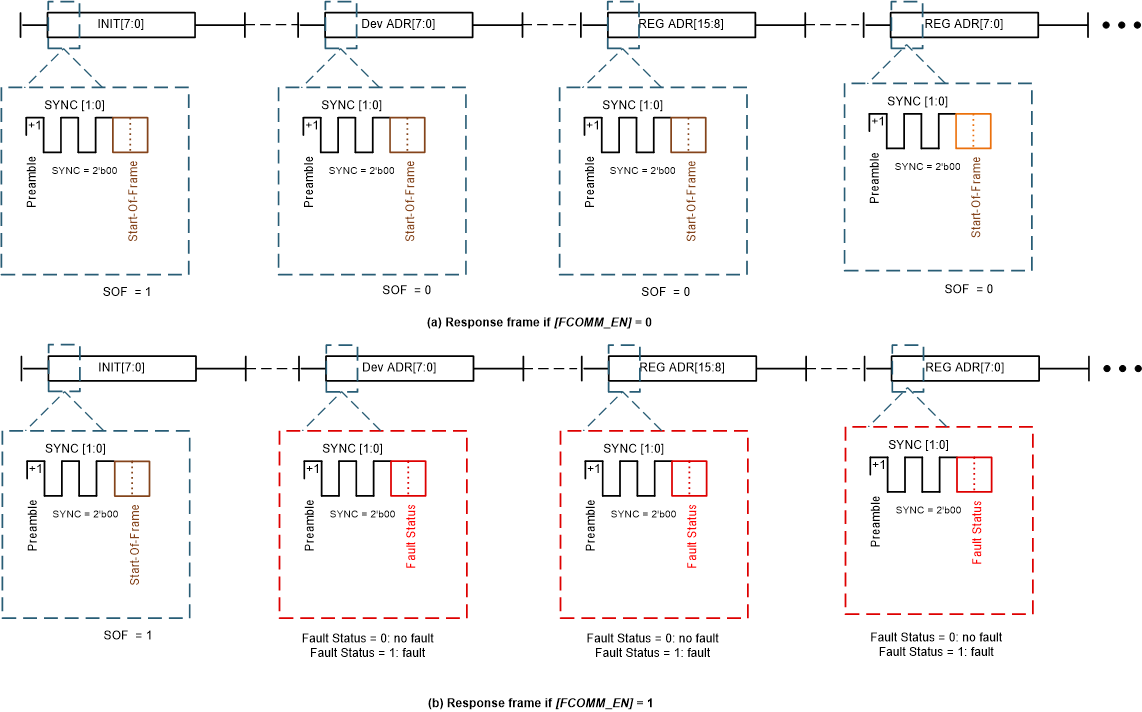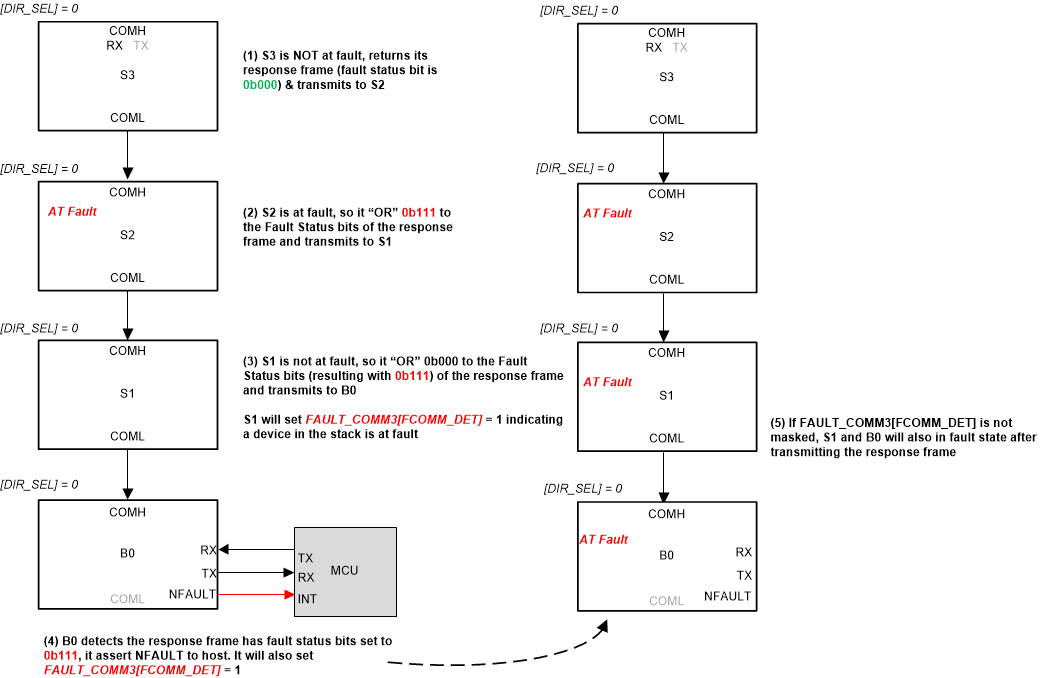SLUSE81E August 2020 – November 2023 BQ79612-Q1 , BQ79614-Q1 , BQ79616-Q1 , BQ79616H-Q1
PRODUCTION DATA
- 1
- 1 Features
- 2 Applications
- 3 Description
- 4 Revision History
- 5 Description (continued)
- 6 Device Comparison Table
- 7 Pin Configuration and Functions
- 8 Specifications
-
9 Detailed Description
- 9.1 Overview
- 9.2 Functional Block Diagram
- 9.3
Feature Description
- 9.3.1 Power Supplies
- 9.3.2 Measurement System
- 9.3.3 Cell Balancing
- 9.3.4 Integrated Hardware Protectors
- 9.3.5 GPIO Configuration
- 9.3.6
Communication, OTP, Diagnostic Control
- 9.3.6.1
Communication
- 9.3.6.1.1 Serial Interface
- 9.3.6.1.2 Daisy Chain Interface
- 9.3.6.1.3 Start Communication
- 9.3.6.1.4 Communication Timeout
- 9.3.6.1.5 Communication Debug Mode
- 9.3.6.1.6 Multidrop Configuration
- 9.3.6.1.7 SPI Master
- 9.3.6.1.8 SPI Loopback
- 9.3.6.2 Fault Handling
- 9.3.6.3 Nonvolatile Memory
- 9.3.6.4 Diagnostic Control/Status
- 9.3.6.1
Communication
- 9.3.7 Bus Bar Support
- 9.4 Device Functional Modes
- 9.5
Register Maps
- 9.5.1 OTP Shadow Register Summary
- 9.5.2 Read/Write Register Summary
- 9.5.3 Read-Only Register Summary
- 9.5.4
Register Field Descriptions
- 9.5.4.1 Device Addressing Setup
- 9.5.4.2 Device ID and Scratch Pad
- 9.5.4.3
General Configuration and Control
- 9.5.4.3.1 DEV_CONF
- 9.5.4.3.2 ACTIVE_CELL
- 9.5.4.3.3 BBVC_POSN1
- 9.5.4.3.4 BBVC_POSN2
- 9.5.4.3.5 PWR_TRANSIT_CONF
- 9.5.4.3.6 COMM_TIMEOUT_CONF
- 9.5.4.3.7 TX_HOLD_OFF
- 9.5.4.3.8 STACK_RESPONSE
- 9.5.4.3.9 BBP_LOC
- 9.5.4.3.10 COMM_CTRL
- 9.5.4.3.11 CONTROL1
- 9.5.4.3.12 CONTROL2
- 9.5.4.3.13 CUST_CRC_HI
- 9.5.4.3.14 CUST_CRC_LO
- 9.5.4.3.15 CUST_CRC_RSLT_HI
- 9.5.4.3.16 CUST_CRC_RSLT_LO
- 9.5.4.4 Operation Status
- 9.5.4.5 ADC Configuration and Control
- 9.5.4.6
ADC Measurement Results
- 9.5.4.6.1 VCELL16_HI/LO
- 9.5.4.6.2 VCELL15_HI/LO
- 9.5.4.6.3 VCELL14_HI/LO
- 9.5.4.6.4 VCELL13_HI/LO
- 9.5.4.6.5 VCELL12_HI/LO
- 9.5.4.6.6 VCELL11_HI/LO
- 9.5.4.6.7 VCELL10_HI/LO
- 9.5.4.6.8 VCELL9_HI/LO
- 9.5.4.6.9 VCELL8_HI/LO
- 9.5.4.6.10 VCELL7_HI/LO
- 9.5.4.6.11 VCELL6_HI/LO
- 9.5.4.6.12 VCELL5_HI/LO
- 9.5.4.6.13 VCELL4_HI/LO
- 9.5.4.6.14 VCELL3_HI/LO
- 9.5.4.6.15 VCELL2_HI/LO
- 9.5.4.6.16 VCELL1_HI/LO
- 9.5.4.6.17 BUSBAR_HI/LO
- 9.5.4.6.18 TSREF_HI/LO
- 9.5.4.6.19 GPIO1_HI/LO
- 9.5.4.6.20 GPIO2_HI/LO
- 9.5.4.6.21 GPIO3_HI/LO
- 9.5.4.6.22 GPIO4_HI/LO
- 9.5.4.6.23 GPIO5_HI/LO
- 9.5.4.6.24 GPIO6_HI/LO
- 9.5.4.6.25 GPIO7_HI/LO
- 9.5.4.6.26 GPIO8_HI/LO
- 9.5.4.6.27 DIETEMP1_HI/LO
- 9.5.4.6.28 DIETEMP2_HI/LO
- 9.5.4.6.29 AUX_CELL_HI/LO
- 9.5.4.6.30 AUX_GPIO_HI/LO
- 9.5.4.6.31 AUX_BAT_HI/LO
- 9.5.4.6.32 AUX_REFL_HI/LO
- 9.5.4.6.33 AUX_VBG2_HI/LO
- 9.5.4.6.34 AUX_AVAO_REF_HI/LO
- 9.5.4.6.35 AUX_AVDD_REF_HI/LO
- 9.5.4.6.36 AUX_OV_DAC_HI/LO
- 9.5.4.6.37 AUX_UV_DAC_HI/LO
- 9.5.4.6.38 AUX_OT_OTCB_DAC_HI/LO
- 9.5.4.6.39 AUX_UT_DAC_HI/LO
- 9.5.4.6.40 AUX_VCBDONE_DAC_HI/LO
- 9.5.4.6.41 AUX_VCM_HI/LO
- 9.5.4.6.42 REFOVDAC_HI/LO
- 9.5.4.6.43 DIAG_MAIN_HI/LO
- 9.5.4.6.44 DIAG_AUX_HI/LO
- 9.5.4.7 Balancing Configuration, Control and Status
- 9.5.4.8 Protector Configuration and Control
- 9.5.4.9 GPIO Configuration
- 9.5.4.10 SPI Master
- 9.5.4.11 Diagnostic Control
- 9.5.4.12 Fault Configuration and Reset
- 9.5.4.13
Fault Status
- 9.5.4.13.1 FAULT_SUMMARY
- 9.5.4.13.2 FAULT_COMM1
- 9.5.4.13.3 FAULT_COMM2
- 9.5.4.13.4 FAULT_COMM3
- 9.5.4.13.5 FAULT_OTP
- 9.5.4.13.6 FAULT_SYS
- 9.5.4.13.7 FAULT_PROT1
- 9.5.4.13.8 FAULT_PROT2
- 9.5.4.13.9 FAULT_OV1
- 9.5.4.13.10 FAULT_OV2
- 9.5.4.13.11 FAULT_UV1
- 9.5.4.13.12 FAULT_UV2
- 9.5.4.13.13 FAULT_OT
- 9.5.4.13.14 FAULT_UT
- 9.5.4.13.15 FAULT_COMP_GPIO
- 9.5.4.13.16 FAULT_COMP_VCCB1
- 9.5.4.13.17 FAULT_COMP_VCCB2
- 9.5.4.13.18 FAULT_COMP_VCOW1
- 9.5.4.13.19 FAULT_COMP_VCOW2
- 9.5.4.13.20 FAULT_COMP_CBOW1
- 9.5.4.13.21 FAULT_COMP_CBOW2
- 9.5.4.13.22 FAULT_COMP_CBFET1
- 9.5.4.13.23 FAULT_COMP_CBFET2
- 9.5.4.13.24 FAULT_COMP_MISC
- 9.5.4.13.25 FAULT_PWR1
- 9.5.4.13.26 FAULT_PWR2
- 9.5.4.13.27 FAULT_PWR3
- 9.5.4.14
Debug Control and Status
- 9.5.4.14.1 DEBUG_CTRL_UNLOCK
- 9.5.4.14.2 DEBUG_COMM_CTRL1
- 9.5.4.14.3 DEBUG_COMM_CTRL2
- 9.5.4.14.4 DEBUG_COMM_STAT
- 9.5.4.14.5 DEBUG_UART_RC
- 9.5.4.14.6 DEBUG_UART_RR_TR
- 9.5.4.14.7 DEBUG_COMH_BIT
- 9.5.4.14.8 DEBUG_COMH_RC
- 9.5.4.14.9 DEBUG_COMH_RR_TR
- 9.5.4.14.10 DEBUG_COML_BIT
- 9.5.4.14.11 DEBUG_COML_RC
- 9.5.4.14.12 DEBUG_COML_RR_TR
- 9.5.4.14.13 DEBUG_UART_DISCARD
- 9.5.4.14.14 DEBUG_COMH_DISCARD
- 9.5.4.14.15 DEBUG_COML_DISCARD
- 9.5.4.14.16 DEBUG_UART_VALID_HI/LO
- 9.5.4.14.17 DEBUG_COMH_VALID_HI/LO
- 9.5.4.14.18 DEBUG_COML_VALID_HI/LO
- 9.5.4.14.19 DEBUG_OTP_SEC_BLK
- 9.5.4.14.20 DEBUG_OTP_DED_BLK
- 9.5.4.15
OTP Programming Control and Status
- 9.5.4.15.1 OTP_PROG_UNLOCK1A through OTP_PROG_UNLOCK1D
- 9.5.4.15.2 OTP_PROG_UNLOCK2A through OTP_PROG_UNLOCK2D
- 9.5.4.15.3 OTP_PROG_CTRL
- 9.5.4.15.4 OTP_ECC_TEST
- 9.5.4.15.5 OTP_ECC_DATAIN1 through OTP_ECC_DATAIN9
- 9.5.4.15.6 OTP_ECC_DATAOUT1 through OTP_ECC_DATAOUT9
- 9.5.4.15.7 OTP_PROG_STAT
- 9.5.4.15.8 OTP_CUST1_STAT
- 9.5.4.15.9 OTP_CUST2_STAT
-
10Application and Implementation
- 10.1 Application Information
- 10.2
Typical Applications
- 10.2.1
Base
Device Application Circuit
- 10.2.1.1 Design Requirements
- 10.2.1.2 Detailed Design Procedure
- 10.2.1.3 Application Curve
- 10.2.2 Daisy Device Application Circuit
- 10.2.1
Base
Device Application Circuit
- 11Power Supply Recommendations
- 12Layout
- 13Device and Documentation Support
- 14Mechanical, Packaging, and Orderable Information
9.3.6.2.3.1 Fault Status Transmitting in ACTIVE Mode
In ACTIVE mode, stack devices can embed their fault status before retransmitting a response frame if DEV_CONF[FCOMM_EN] = 1. When the [FCOMM_EN] = 1, the stack devices repurpose the SOF bit in the response frame’s device address byte, register address bytes (both high and low address bytes) to a fault status bit instead. See Figure 9-42. This will be referred to as fault status bits in the rest of this section.
 Figure 9-42 Embed Fault Status in Communication Response Frame
Figure 9-42 Embed Fault Status in Communication Response FrameTo pass on the fault status of the stack devices, the host sends a broadcast read or sends a single device read to the ToS device. Both types of reads will result in response frames passing through every device in the daisy chain, giving each device an opportunity to OR their fault status to the fault status bits in the response frame.
An example of a response frame going through a daisy chain from a single device read command to the top device is shown in Figure 9-43.
 Figure 9-43 Transfer Fault Status in ACTIVE Mode (Respond to a Single Device Read)
Figure 9-43 Transfer Fault Status in ACTIVE Mode (Respond to a Single Device Read)When a device has no fault, it will OR the fault status bits with 0b000; otherwise, it will OR the fault status bits with 0b111. Hence, if a fault exists in any device in the daisy chain, the fault status bits will be 0b111. For the base device to assert the NFAULT pin, it requires at least two bits of the fault status bits to be 1.
Additionally, when a device detects a response frame with at least two of the fault status bits being 1, the device will also set the FAULT_COMM3[FCOMM_DET] = 1. If this fault is not masked, the device will be in fault state as well. Next time a response frame is transmitted, this device will OR the fault status bits with 0b111.
Host performs a broadcast read to detect which device in the daisy chain is at fault and what type of fault.